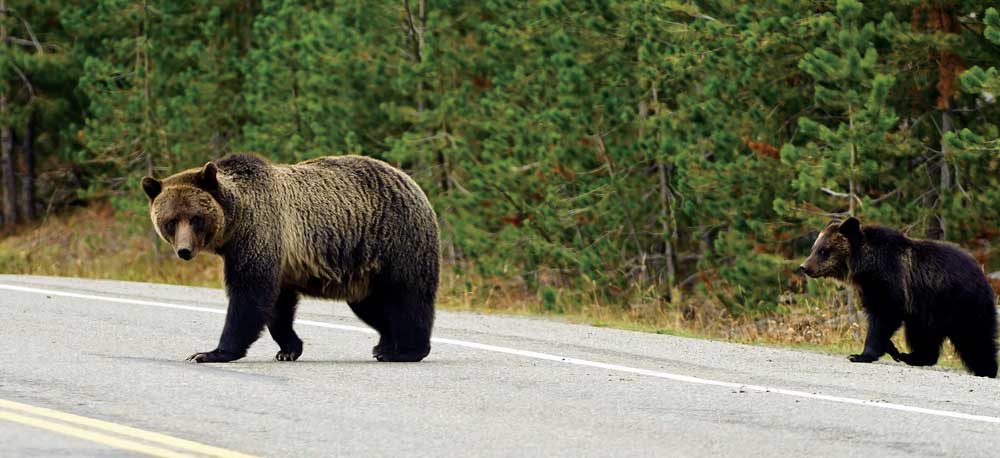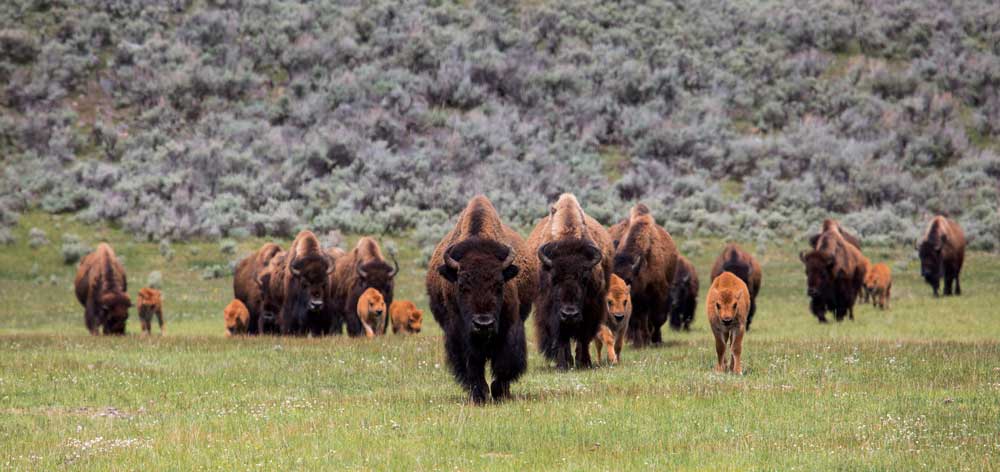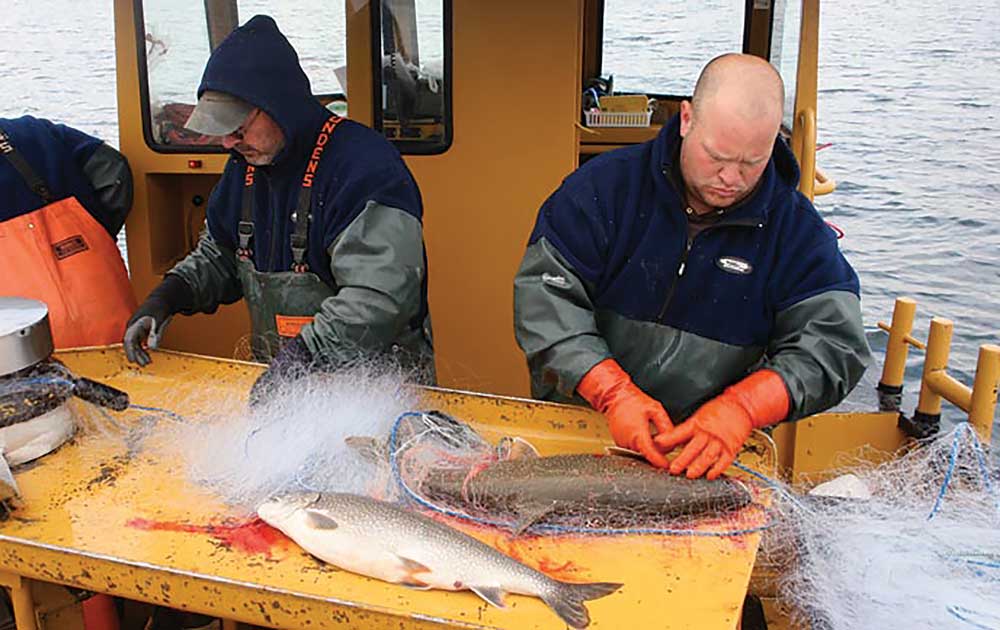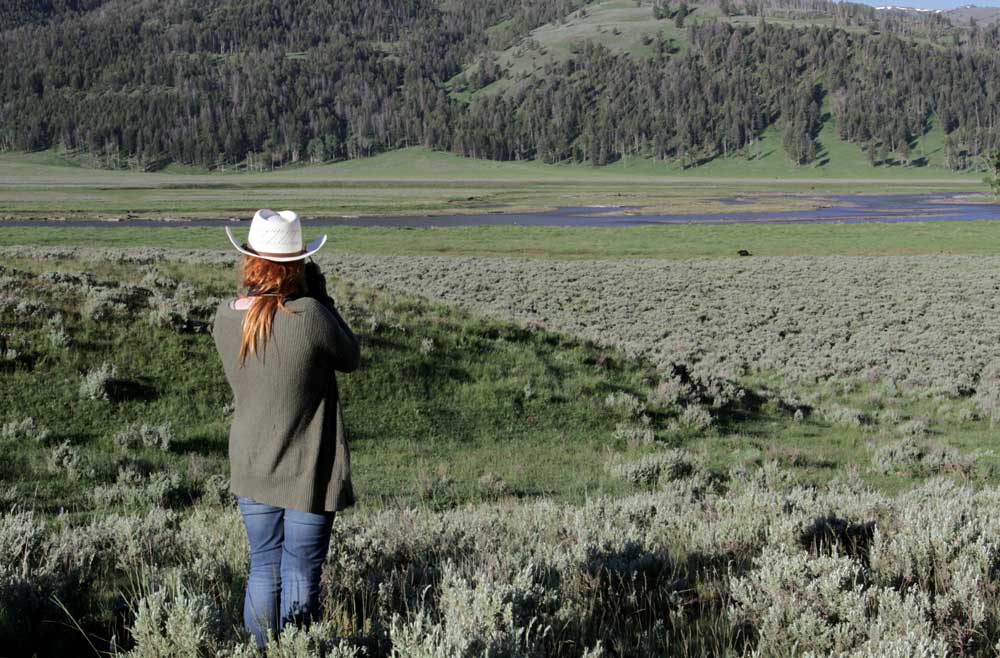“He’s coming!” a fellow backpacker yelled. And with that, six hundred pounds of grizzly bear charged us, heading up the tanned grassy slope where we were positioned along a stand of lodgepole pines. As the scene unfurled and the grizzly heaved towards us, it was hard not to notice his large, ivory-colored claws leading the way.
Pelican Valley in Yellowstone National Park might just be the closest thing to America’s Serengeti. Situated on the north end of Yellowstone Lake, the valley is a broad sweep of grasslands full of bison, bears, elk, and wolves.
It’s no roadside attraction. You have to hike a decent distance to get into the valley. There are strict rules, unique to hiking trails in Yellowstone. Because of grizzly bear activity, the trail does not open until July 4 each year, and hiking is only allowed between 9 a.m. and 7 p.m. Camping is prohibited.
Our group was part of a Yellowstone Association Institute backpacking course to study grizzlies in the valley. Led by Yellowstone bear management chief Kerry Gunther, we had come across a bison carcass along Pelican Creek. Initially brought down by wolves, the bears now claimed the prize.
Five other grizzlies tried to make a meal of the bison, but a big boar grizzly was its current owner—sitting at the top of the food chain among others who are at the top of the food chain. We tried to maintain a safe distance from the action, positioning ourselves on the grassy slope above. But when the grizzly had his fill, he moved up the creek right in front of our position. Now about one hundred yards away, he decided to take a nap, trapping us between the creek and the trees.
We were stuck. It was late afternoon, and we still had six miles of hard hiking ahead of us over Mist Creek Pass. Crouched low to the ground, Gunther whispered that we should gather our gear quietly. As we did, the grizzly awoke with a jolt and charged right at us. We stood up, readying our canisters of bear spray. At forty yards, the bear veered off its path, diving into the lodgepole forest. Full of adrenaline and still breathing heavily, I thought to myself, I just paid $400 for this up close and personal experience. A bargain.
BEAR NECESSITIES
Our national parks are home to some of the most popular wildlife in the world. Yellowstone, in particular, is a land of charismatic megafauna, the closest most visitors will get to a real-life Jurassic Park. And it’s the reason they come.
What began as a destination to see thermal features, geysers, and massive waterfalls, Yellowstone has become the place to view wildlife. Asked in a survey what they wanted to see in Yellowstone, visitors said they wanted to see bears as much as they wanted to see Old Faithful, with general “wildlife” coming in third. Impressive for the bears, since the people questioned were sitting right in front of Old Faithful waiting for it to erupt.
Across America, wildlife-based recreation generates big money. According to a survey by the U.S. Fish and Wildlife Service, 90 million people participate in wildlife viewing, fishing, and hunting each year, resulting in more than $144 billion in expenditures. At a time when the National Park Service struggles with nearly $11.5 billion in unfunded maintenance projects such as hiking trails, water systems, and buildings in disrepair, wildlife in the national parks has tremendous value. And yet the National Park Service captures very little of it.
The idea that wildlife is an under-valued asset was recently road-tested in Yellowstone—literally. In a recent study, Yellowstone bear manager Kerry Gunther and other researchers found that visitors would pay more than double the $25 entry fee if it would increase their chances of seeing a bear. Rather than hazing roadside bears back into the interior of the park, bear managers today have a policy of “letting bears be bears.” Instead, they manage the visitors viewing bears along the 300 miles of paved roads in Yellowstone. In a given year, there can be more than 1,000 of these “bear jams,” putting significant stress on ranger resources.
According to the study, visitors would pay an average of $41 on top of the park entry fee to continue Yellowstone’s policy of roadside bear management. Gunther and his team estimate that if Yellowstone no longer allowed bears on roadside habitats, local economies might lose up to $10 million annually.
“We always knew how much visitors valued viewing bears, but we hadn’t really considered the bears’ economic value and what that means to the Park and gateway communities,” said Gunther.
SAVING THE LORDLY BUFFALO
Capturing the value of wildlife in national parks is a thorny subject that brings up accusations of commercialization and breach of the public trust doctrine, even if the benefits to the public and wildlife are clear. Just ask Ted Turner.
Another one of Yellowstone’s popular wildlife species is the iconic American bison. A triumph of conservation, the bison are thriving in the park. In 1902, after decades of poaching and market hunting, only about two dozen bison remained in Yellowstone. A century of public and private conservation efforts have brought the bison back from the precipice of extinction. Today, Yellowstone is home to nearly 5,000 of what Theodore Roosevelt called “the lordly buffalo.”
Yet Yellowstone’s bison abundance has not come without drawbacks. Bison are migratory, preferring to move across vast landscapes. In the park, some carry brucellosis, a disease that can be passed on to domestic cattle, threatening the beef industry of neighboring states. In winter, when forage in Yellowstone’s high elevation is limited, bison migrate out of the park and into Montana. That’s when the trouble begins.
The park deals with this problem by limiting the size of the bison population through culling and hunting. All of this costs the National Park Service about $1.2 million per year. The culled bison, nearly 1,000 this past season, are sent to slaughter.
This scene is repeated in other national parks in the West. Wind Cave, Badlands, and Theodore Roosevelt national parks each have bison culling operations in which another 1,000 bison are donated each year to American Indian tribes.
But the Yellowstone bison are unique. They are truly wild. They are the descendants of the last free-roaming herds—high country holdouts that were exposed over time to predators, harsh climate, and, unlike other bison herds, show no genetic interbreeding with cattle. For this reason, they too have value to the national park—and to others.
Enter Ted Turner, who has a passion for bison restoration and manages more than 50,000 bison across his various ranches. In the mid-2000s, federal and state agencies initiated a quarantine program to certify some of the captured bison roaming out of Yellowstone as brucellosis free. With the brucellosis-free designation, the bison could be transferred to other bison herds in the West. It was one way to avert slaughter. But after five years of intensive testing, the state of Montana was in need of a new facility to house and continue testing the herd for another five years.
With few options available, the agencies turned to Turner who agreed to take 87 of the quarantined Yellowstone bison and care for them on his Green Ranch, part of the 113,000-acre Flying D Ranch near Bozeman, Montana. Turner agreed to do this free of charge, at no cost to taxpayers, in exchange for 75 percent of the offspring born while in his care. At the end of five years, in order to help establish new herds across the West, the state would get all the original bison back, brucellosis free, along with 25 percent of the offspring. Turner would get the opportunity to keep and raise a genetically unique bison herd.
This was a big breakthrough for the National Park Service and Montana. They were slaughtering a lot of bison, and this plan had the potential to bring Yellowstone genetics out of the park and disperse them.
Capturing the value of wildlife in national parks is a thorny subject, even if the benefits to the public and wildlife are clear.
Some environmental organizations vigorously opposed the deal. “Allowing public wildlife—wildlife from America’s first national park—to be privatized and commercialized sets a dangerous precedent,” the Natural Resources Defense Council wrote at the time. “Yellowstone’s public wildlife is not a form of currency.”
That said, the alternative was a death sentence for the Yellowstone bison. The bison calves that were part of the deal would not even exist were it not for Turner’s offer. And the commercialization argument ignores the fact that today bison from other national parks, such as Badlands and Theodore Roosevelt, are sent alive and kicking—and free of charge—to American Indian tribes, who can sell the bison and keep the cash.
Despite opposition, the deal with Turner moved forward. In November 2014, after a lawsuit and five years of husbanding the small herd, the state of Montana approved the transfer of 139 wild, brucellosis-free Yellowstone bison from Turner’s ranch to the Fort Peck Indian Reservation in northern Montana for conservation. Turner kept 152 of the valuable, genetically unique Yellowstone bison, with a range of alternatives for their future, including commercial uses.
The whole project is proof of a market for the surplus bison leaving Yellowstone and a higher and better use than slaughter. Ted Turner’s individual self-interest aligns, as it often does, with wildlife conservation. The benefits go to Turner, the park, the public, and most importantly, the bison, which thanks to Ted Turner will be around long after he’s gone.
THE TALE OF TWO BISON
As the National Park Service navigates the minefields of wildlife policy, there are other federal and state conservation units across the country finding innovative ways to use their wildlife assets for the benefit of habitat and wildlife management.
While Wind Cave and Badlands national parks in South Dakota are essentially gifting their bison, their next door neighbor, Custer State Park, auctions its surplus bison to help pay for park operations. Custer’s herd of 1,300 bison are descendants of some of the last free-ranging bison left in the early 1900s, protected by entrepreneurial cattle rancher Frederick Dupree, who recognized the value of saving the iconic species.
Each year, the state park hosts a roundup, drawing 14,000 people from around the world to this remote slice of America. Like a scene out of Dances with Wolves, cowboys and cowgirls on horseback stampede the shaggy beasts out of the park’s backcountry, past cheering crowds and into corrals. The bison auction is needed to keep the population in check with available rangeland forage. In 2014, the auction resulted in nearly $380,000 from the sale of 223 bison. Combined with bison hunting revenue, the bison sales brought in half a million dollars for the state park system.
As the Rapid City Journal noted this year, “The bison at national parks roam land owned by the American people. So why are national parks giving away bison for far less, and only to certain groups?” Local bison rancher Dan O’Brien, a conservationist, echoed similar sentiments. “I’m not opposed to those buffalo going to the tribes, but I can certainly understand why it would upset some people,” he said. “The parks have a really hard time and are just starved for money, and here’s an opportunity to soak up a few hundred thousand dollars.”
SHED WARS
Sixty miles south of Yellowstone sits the National Elk Refuge in Wyoming, also managed by the federal government. In the winter, the refuge hosts 6,000 to 8,000 elk seeking lower elevations and forage.
As the snows begin to melt, the elk lose their antlers. These “sheds,” as they are called, find their way into Western art, furniture, and chandeliers that sell for thousands of dollars. The refuge even sells individual elk tines for $20 as an all-natural dog chew. Shed collecting has become such big business that there is now a reality show called “Shed Wars” on the Sportsman Channel.
In Yellowstone, it is illegal to harvest the elk sheds. In the National Elk Refuge, it’s a source of conservation funding to help manage the elk herd.
Each year, Boy Scouts collect thousands of pounds of naturally shed elk antlers from the refuge—more than 10,000 pounds this year alone—and sell those antlers at auction. Seventy-five percent of the proceeds go back to the National Elk Refuge, while 25 percent goes to the Boy Scouts. The funds to the refuge are then used for habitat enhancement work on 25,000 acres of winter range for the elk.
Bidders paid a record-setting average of $17 per pound this year, resulting in nearly $200,000 in sales—the second highest total in the auction’s 48-year history. That’s the equivalent of park entry fees for 8,000 carloads of visitors to Yellowstone.
TROUT SLAYERS
Another potentially under-utilized wildlife resource for Yellowstone National Park is its trout—not the Yellowstone cutthroat trout that many love to fish, but the invasive lake trout that are threatening the existence of the native “cutties.” Illegally introduced to Yellowstone Lake, the lake trout compete with the Yellowstone cutthroat trout for food. More often than not, they simply eat the cutthroats.
As a result, the native cutthroat population has been decimated, making the war on lake trout one of the park’s greatest conservation priorities. The park has deployed gill-netters on Yellowstone Lake, along with 30 miles of net, in an effort to crash the lake trout population—a project costing $2 million a year. The good news is that the gill-netters are making some progress, taking 200,000 lake trout a year, and the cutthroats are rebounding. But what happens to all that lake trout?
If you think they are sold and end up as a locally sourced delicacy at the historic Lake Yellowstone Hotel, you would be wrong. After the lake trout are hauled on to the boat, they are measured and weighed and then disposed of with a slice to the belly. The dead trout are tossed back into the waters of Yellowstone Lake.
According to the park, this is the easiest way to deal with them. Park personnel say processing the fish would be a challenge. There are costly rules and regulations that apply to food, and nets would have to be hauled in more frequently. The economics just might not work. But they are also concerned that if commercial fishing were allowed, they would create incentives and demand for more of something they are trying to eradicate.
Putting aside the possibility of generating revenue to offset the costs of the lake trout program, the National Park Service’s money-making concerns run counter to the approach of other agencies that are trying to take down invasive fish species.
In Florida, for example, the colorful, non-native lionfish has been decimating native reef fish species for years in both the Atlantic Ocean and the Gulf of Mexico. The state is working with a broad coalition, including renowned wildlife artist Guy Harvey and celebrity chefs, to create private incentives for harvesting lionfish. This includes developing a market for the meat, organizing lionfish derbies, and recently approving a “lobsters for lionfish” program that would enable divers to harvest additional Florida lobsters in exchange for capturing and killing a certain number of lionfish.
Even the National Park Service’s sister agency, the National Oceanic and Atmospheric Administration has launched an “Eat Lionfish” campaign to bring together fish wholesalers and chefs in an effort “to broaden U.S. consumers’ awareness of this delicious invader.” Indeed, incentives can cut both ways.
THE COMMERCIALIZATION CONUNDRUM
America’s national parks are much-needed refuges for some of our most critical wildlife species. Yellowstone is right to take a careful approach in capturing the economic value of its number one attraction. The park holds a special place in the annals of wildlife conservation. The animals Yellowstone protects are the best of “America’s best idea.” “Here,” said Teddy Roosevelt in 1903, “all the wild creatures of the old days are being preserved.”
But commercialization is, to some degree, always present and always in the eye of the beholder. As former PERC research associate J. Bishop Grewell notes, “Realistically, any Yellowstone visitor who has bought a moose-head hat, paid a lobster-dinner price for a scoop of ice cream at Old Faithful, or simply paid the park’s entry fee has commercialized Yellowstone.” In fact, Yellowstone owes its very founding in part to the private commercial interests of the Northern Pacific Railroad. The park has even been a leader in advancing benefits-sharing agreements with companies seeking to profit from research in the park. In Yellowstone, microbe research in thermal areas made DNA fingerprinting and analysis possible. With benefits-sharing agreements, royalties from similar research could yield millions in revenue for the park.
In the end, what really counts is not whether a dollar has exchanged hands, but whether the activity stays true to the National Park Service’s mission and provides a benefit to the wildlife and habitat it is trying to preserve. In the case of genetically unique bison destined for the slaughterhouse, massive roadside “bear jams,” or native trout in need of restoration, there is ample room to capture the value of Yellowstone’s wildlife to better protect the park’s resources for future generations. Call it whatever you want—what matters is that it works for the wildlife.







